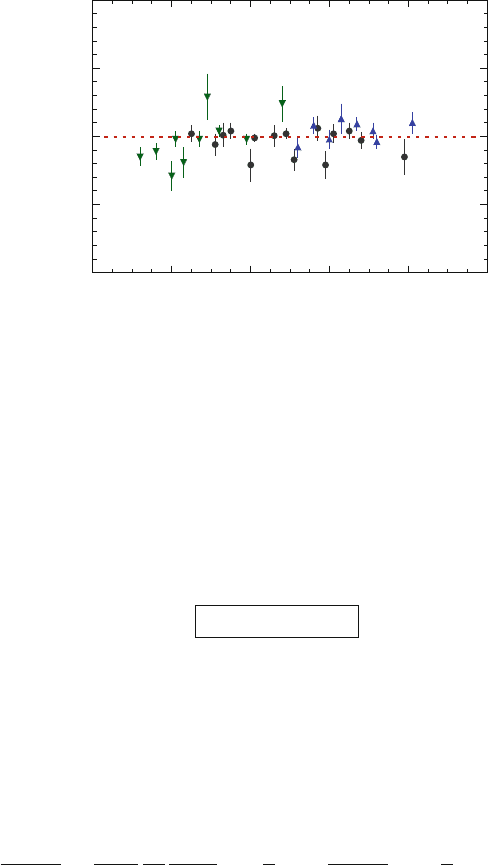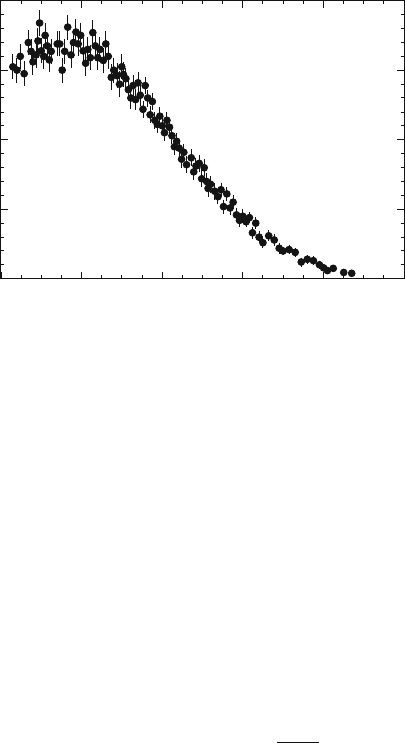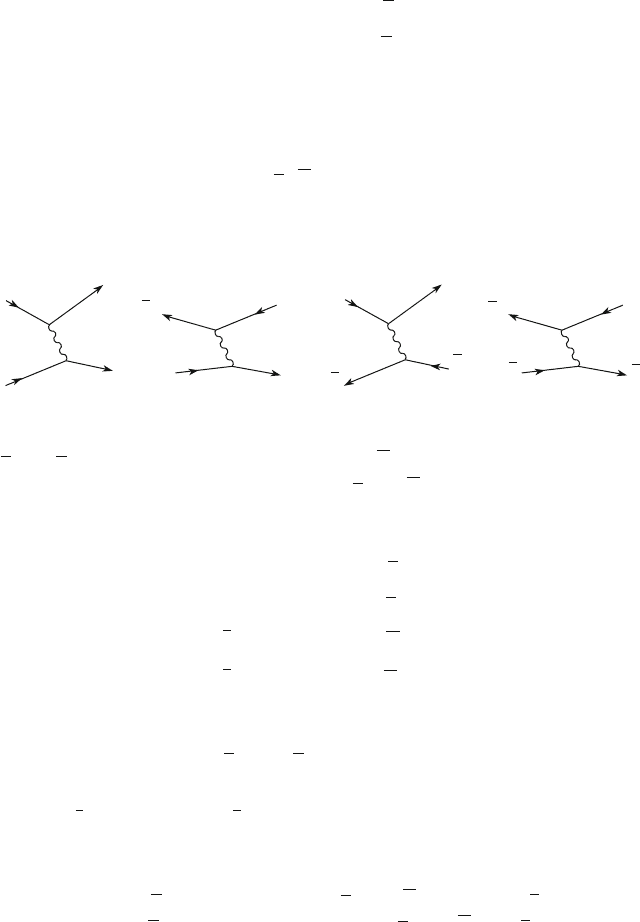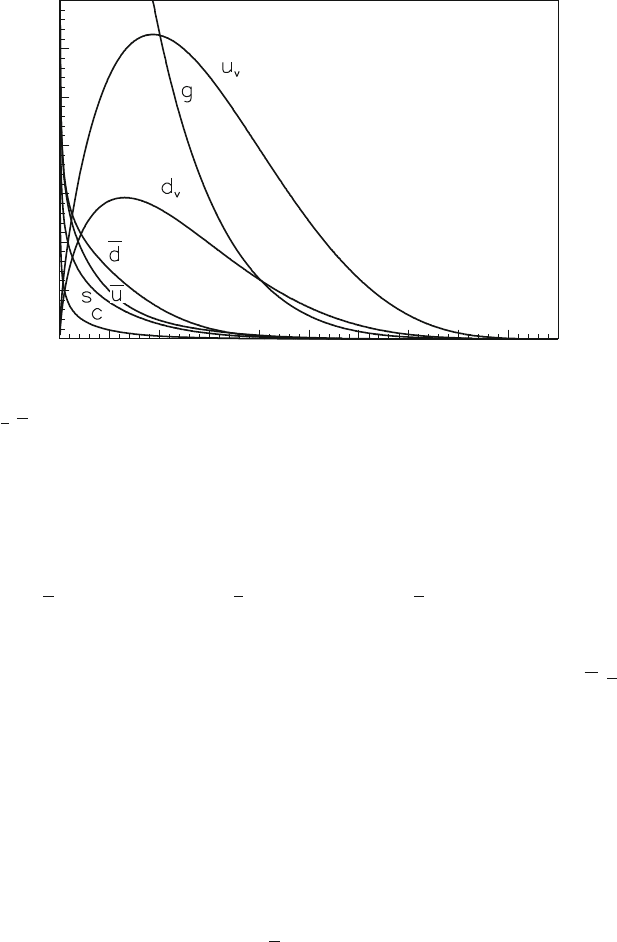Braibant S., Giacomelli G., Spurio M. Particles and Fundamental Interactions: An Introduction to Particle Physics
Подождите немного. Документ загружается.


10.4 Inelastic ep Cross-Section 279
0
0.5
1
1.5
2
0 0.2 0.4 0.6 0.8 1
x
2xF
1
(x) / F
2
(x)
Fig. 10.8 Ratio 2xF
1
.x/=F
2
.x/ as a function of the variable x for different Q
2
values. The figure
refers to SLAC experimental data with .H/1:5<Q
2
<4GeV
2
; ./5<Q
2
<11GeV
2
and
.N/12<Q
2
<16GeV
2
The two Bjorken structure functions F
1
and F
2
are not independent if the nucleon
constituents are spin 1/2 fermions. Comparing the cross-section (10.38) with that of
the elastic interaction of leptons on spin 0 particles (10.14) or on spin 1/2 particles
with mass m D Mx (10.16a), we deduce that
• For spin 0 constituents, one has F
1
.x/ =0.
• For spin 1/2 constituents, one has
F
2
.x/ D 2xF
1
.x/; (10.38)
known as the Callan-Gross relation.
Figure 10.8 shows the value of the ratio 2xF
1
.x/=F
2
.x/ measured at different
Q
2
and . The ratio is clearly different from zero and remains constant and
approximately equal to one. Therefore, deep inelastic scattering experiments of
electrons show that protons and neutrons consist of spin 1/2 point-like constituents.
Using the Callan-Gross relation, Eq. 10.38 can be written as
d
2
dQ
2
dx
D
4˛
2
Q
4
E
0
E
F
2
.x/
x
cos
2
2
1 C
Q
2
4M
2
x
2
2 tan
2
2
: (10.39)
This relation has an attractive interpretation in the parton model introduced by
Feynman in 1969. He considered the inelastic collision in a reference system in
which the hadron target has high momentum (jpjM ) so that the constituent
masses and the transverse momenta can be neglected:
• The hadron consists of charged point-like particles called partons.
• The four-momentum P
o
of the hadron is distributed among the partons.

280 10 High Energy Interactions and the Dynamic Quark Model
0
0.1
0.2
0.3
0.4
0 0.2 0.4 0.6 0.8 1
x
F
2
(x)
Fig. 10.9 Experimental measurements of the proton structure function F
ep
2
.x/ as a function of the
variable x. Note that
R
1
0
F
2
.x/dx ' 0:14
• The inelastic interaction with transferred four-momentum Q and energy is the
result of elastic scattering on a parton with four-momentum xP
o
.
• The structure function F
2
.x/=x represents the distribution function of partons in
the nucleon.
This is the mechanism presented in Fig. 10.2. The square of the total electron-
parton energy is
s D .P C xP
o
/
2
D 2EM x Cx
2
M
2
C M
2
' 2EM x .E M/ (10.40)
and the four-momentum Q is exchanged between the electron and the parton. The
parton four-momentum after the interaction (recalling 10.35)is
.q CxP
o
/
2
DQ
2
C2M xCx
2
M
2
DQ
2
C2M
Q
2
2M
C.xM /
2
D m
2
W
2
(10.41)
and the hadron fragments into a final state with invariant mass W . The final state
also contains the remaining partons carrying the residual four-momentum .1x/P
o
.
The function F
2
.x/ measured in electron-proton deep inelastic scattering is shown
in Fig. 10.9.
10.4.2 Electric Charge of the Partons
The nucleon is made of point-like partons of spin 1/2. One may wonder if the
partons can be identified with the quarks. Quarks have fractional electric charge,
e
u
D 2=3 and e
d
D e
s
D1=3, in units of the elementary charge. The cross-section

10.4 Inelastic ep Cross-Section 281
for electromagnetic interactions is proportional to the electric charge squared: the
interaction of an electron with a parton with a charge e
u
has a larger probability
to occur with respect to the interaction with a parton with a charge e
d
by a factor
e
2
u
=e
2
d
D 4. Denoting with f
k
.x/ the density in the nucleon of quarks of flavor k,
the structure function F
2
.x/ must take into account the different couplings with the
parton electric charges through the constants e
k
D e
u
;e
d
;e
s
,thatis,
F
2
.x/ D
X
k
e
2
k
x f
k
.x/: (10.42)
Quark-antiquark pairs of the same flavor can also be produced in a deep inelastic
interaction; the electromagnetic coupling constant has the same value for quarks
and antiquarks. It is convenient to define the quarks that define the hadron quantum
numbers as valence quarks: the proton jpiDjuud i has two valence quarks u and a
valence quark d; the neutron jniDjuddi has a u quark plus two d valence quarks.
The sea quarks are virtual quark-antiquark pairs of mass m
q
, produced inside the
nucleon through the strong interaction. Sea quark pairs are continuously created;
they survive for a time interval t such that t 2m
q
< „, as the virtual e
C
e
pairs
in Fig.4.2f. The creation of c;b;t pairs is disfavored because of their high mass
value.
Starting from (10.42), the proton and neutron structure functions may be
measured using incoming electrons:
F
ep
2
D x
4
9
Œ.u
p
.x/ C u.x/ C
1
9
Œ.d
p
.x/ C d.x/C s.x/ C s.x/
(10.43a)
F
en
2
D x
4
9
Œ.u
n
.x/ C u.x/ C
1
9
Œ.d
n
.x/ C d.x/ C s.x/ C s.x/
(10.43b)
u
p
.x/, d
p
.x/ are respectively the densities of u and d quarks in the proton;
u
n
.x/; d
n
.x/ are those in the neutron. Sea pairs uu;dd;ss have approximately
the same density in the proton and in the neutron (the indices n; p are not indicated)
and the contribution of higher mass quarks is negligible. The isospin symmetry in
hadronic interaction leads to the hypothesis that the density of u valence quarks in
the proton is equal to the density of d valence quarks in the neutron. The role of u
quarks in the proton corresponds to that of d quarks in the neutron, that is,
u
p
.x/ D d
n
.x/ D u
v
.x/I d
p
.x/ D u
n
.x/ D d
v
.x/: (10.43c)
With this hypothesis, the proton and neutron structure functions become
F
ep
2
D x
4
9
.u
v
C u/ C
1
9
.d
v
C d Cs C s/
I
F
en
2
D x
4
9
.d
v
C d/C
1
9
.u
v
C u C s C s/
: (10.44)

282 10 High Energy Interactions and the Dynamic Quark Model
In a target with equal numbers of protons and neutrons (called isoscalar target), for
example, deuterium, the numbers of u and d quarks are equal; a structure function
averaged over the content of the valence and sea quarks is
F
eN
2
D
F
ep
2
C F
en
2
2
D x
5
18
.u
v
C u/ C
5
18
.d
v
C d/C
2
18
.s C
s/
'
5
18
x
q.x/ C
q.x/
(10.45)
where q.x/ indicates the sum of quark densities, and
q.x/ that of the antiquarks.
The integral of xŒq.x/ C
q.x/ over x must be equal to one since it represents
the contribution to the interaction of all quarks and antiquarks. The measured value
of the integral of F
eN
2
in the region 1<Q
2
<10(GeV/c)
2
is about 0.14 (see
Fig. 10.9). Therefore, one has
Z
1
0
xŒq.x/ C q.x/dx '
18
5
Z
1
0
F
eN
2
.x/dx ' .0:50 ˙ 0:05/: (10.46)
This value was obtained with deep inelastic scattering of electrons and muons (the
muons can reach higher energies) on different isoscalar targets (deuterium, carbon,
etc.). The result is approximately independent of the transferred Q
2
and .We
conclude that the partons (spin 1/2 fermions) carry about 50% of the total nucleon
momentum.
The above result can be explained if not all partons couple with the electromag-
netic field, or if there are other objects, in addition to the quarks, inside the nucleon.
It is possible to test these hypotheses by studying the neutrino-nucleon DIS; in this
case, the interaction does not couple with the quark electric charge.
10.5 Cross-Section for CC
N Interactions
beams are produced via the decay of charged pions, as described in Sect. 8.7. A
final state muon is generated through a
charged current interaction. The following
deep inelastic scattering interactions were studied in detail, that is,
p !
C X
CC
;
p !
C
C X
0
(10.47)
n !
C X
C
;
n !
C
C X
: (10.48)
These weak interaction processes have very small cross-sections; therefore, the
sensitive mass of the experiments should be very large in order to detect a reasonable
number of events. The individual interacting neutrino energy cannot be measured,
and only the neutrino flux per energy unit, d˚=dE
, is known. The energy of the
interacting neutrino is estimated by measuring both the direction and energy of the
muon, and the direction and energy of the hadronic system X formed in the nucleon
fragmentation.

10.5 Cross-Section for CC
N Interactions 283
The differential neutrino (or antineutrino) cross-sections in the laboratory system
contain three functions, W
1
.Q
2
;/;W
2
.Q
2
;/and W
3
.Q
2
;/,thatis,
d
2
p
dQ
2
d
D
G
2
F
2
E
E
cos
2
2
W
2
C 2 sin
2
2
W
1
E
C E
M
sin
2
2
W
3
: (10.49)
Comparing Eq. 10.49 with Eq. 10.31 obtained for the electromagnetic case, the
replacement 4˛
2
=Q
4
! G
2
F
=2,whereG
F
is the Fermi constant, can be noted.
For clarity, the energy of the incident particle E is replaced with E
, and that of the
final lepton E
0
is replaced with E
. In the third addendum, the sign is valid for the
case, and the C sign for the
. Equation 10.49 contains three structure functions
W
i
.Q
2
;/ for the proton, and three others for the neutron. These correspond to
the three helicity states of the W
C
or W
massive bosons. There are four terms
which correspond to amplitudes for which the nucleon changes the spin direction
(/ sin
2
) or does not (/ cos
2
). Neutrinos and antineutrinos are helicity eigenstates
with opposite eigenvalues and this gives rise to the difference in sign in the W
3
term.
The functions W
2
and 2W
1
W
3
.E
C E
/=M can be measured because the
differential cross-section (10.49) has a dependence on the muon emission angle .
W
1
and W
3
can be separated using both
and
beams. As in the case of the
photon, the Bjorken scaling law predicts that for Q
2
M
2
and M ,the
structure functions only depend on x D Q
2
=2M; thus, one has
W
2
.Q
2
;/! F
2
.x/I MW
1
.Q
2
;/! F
1
.x/I W
3
.Q
2
;/! F
3
.x/: (10.50)
The differential cross-section (10.49) can be expressed in terms of two dimension-
less variables. In addition to the Bjorken x,theinelasticity is a kinematic variable
that sometimes replaces Q
2
, and it is defined as
y D
E
: (10.51)
In an elastic collision, Eq. 10.9 provides the relation between Q
2
, the scattering
angle and the initial and final energies. Using the definition (10.35)forx, one
has D Q
2
=2Mx and y D Q
2
=2MxE. For this reason, at fixed x, one has dQ
2
D
2MExdy,thatis,
d
2
dxdy
D 2MxE
d
2
dxdQ
2
. Hence, from (10.9), one obtains
Q
2
D 2Mx D 2E
E
.1 cos / (10.52a)
(E D E
, E
0
D E
) from which:
E
D
E
Mx
.1 cos / (10.52b)
y D
E
Mx
.1 cos / D 2
E
Mx
sin
2
2
: (10.52c)

284 10 High Energy Interactions and the Dynamic Quark Model
Fig. 10.10 Elastic scattering
(anti)neutrino-(anti)quark in
their center of mass system.
The black arrows indicate the
direction of the particle
momentum, whereas the
white arrows represent their
spin direction
ν
d
u
θ*
μ
μ
ν
u
d
u
d
μ
ν
ν
μ
d
u
In terms of the dimensionless variables x and y,Eq.10.49 becomes
d
2
;
dx dy
D
G
2
F
ME
1 y
Mxy
2E
F
2
C xy
2
F
1
xy
1
y
2
F
3
: (10.53)
For E
M ,thetermMxy=2E
can be neglected. The numerical value of the
constant at the beginning of the formula is
0
D G
2
F
M= D
1:1664 10
5
2
0:93827=
.„c/
2
cm
2
D 1:58 10
38
cm
2
GeV
1
: (10.54)
For spin 1/2 constituents, the Callan–Gross relation F
2
.x/ D 2xF
1
.x/ can be used.
Consequently, Eq. 10.53 can be rewritten as
d
2
;
dxdy
D
0
2
E
F
2
.x/ xF
3
.x/
.1 y/
2
C
F
2
.x/ ˙ xF
3
.x/
: (10.55)
Note that the equation is of the type
d
2
dxdy
D A.x/.1 y/
2
C B.x/: (10.56)
This relation takes a more explicit meaning in the neutrino-parton center of mass
system. In this reference system, the quark (antiquark) coupling with the W vector
boson must have negative (positive) helicity, assuming that quarks have negligible
masses. Neutrinos and antineutrinos are helicity eigenstates. The only possible
interactions between quarks and
,
, shown in Fig. 10.10,are
d !
u () J D 0
u !
d (( J D 1

10.5 Cross-Section for CC
N Interactions 285
u !
C
d )) J D 1
d !
C
u )( J D 0: (10.57)
The arrows represent the relative direction between the spins of incident particles,
and thus the total angular momentum before collision. Remember that
• The total angular momentum is J D 0 if the two particles in the final state
have opposite spins .)(I()/. The angular distribution of the
emitted particles in the c.m. system is isotropic: F./ D 1. Thus, the cross-
section angular distribution (also in terms of the inelasticity variable) does not
contain any angular dependence, that is,
d
d˝
D
G
2
F
4
2
sI
d
dy
D
G
2
F
s: (10.58)
It is left as an exercise to show that using (10.52), one has
dy
d˝
D
1
4
.
• The total angular momentum is J D 1 if the two particles have parallel spins in
the final state .))I((/. The angular distribution of emitted particles
is described by the eigenfunctions of the rotation matrix for spin 1 particles (as in
the
CC
case discussed in Sect. 7.5.1), and F./ D
1Ccos
2
. The cross-section
angular distribution is
d
d˝
D
G
2
F
4
2
s
1 C cos
2
2
I
d
dy
D
G
2
F
s.1 y/
2
: (10.59)
Let us now transfer from the c.m. to the laboratory system. In the high energy limit,
one obtains from Eq. 10.11 that the invariant variable s is s ' 2ME
. For a collision
with a parton of mass m D xM and taking into account the coupling (10.57)of
neutrinos and antineutrinos with quarks and antiquarks, one has
d
2
dx dy
'
2G
2
F
ME
xq.x/ C x
q.x/.1 y/
2
(10.60)
d
2
dx dy
'
2G
2
F
ME
xq.x/.1 y/
2
C xq.x/
; (10.61)
where q.x/ or
q.x/ are the quark or antiquark density distribution inside the
nucleon. Comparing these two equations with (10.55), one obtains
1
2
F
2
.x/ xF
3
.x/
D 2xq.x/ (10.62a)
1
2
F
2
.x/ C xF
3
.x/
D 2xq.x/; (10.62b)

286 10 High Energy Interactions and the Dynamic Quark Model
that is,
F
2
.x/ D 2xŒq.x/ C q.x/ (10.62c)
xF
3
.x/ D 2xŒq.x/ q.x/: (10.62d)
The structure functions F
2
and F
3
=x describing the neutrino scattering on protons
are proportional to the sum and difference of the parton/antiparton densities.
Identification of fermionic partons with the valence and sea quarks. If the
partons are identified with the u;d;
u; d quarks, the charged current interactions of
neutrinos and antineutrinos on protons are expected to correspond to the elementary
processes (10.57):
μ
+
W
–
d
u
ν
μ
μ
–
W
+
u
d
ν
μ
μ
+
W
–
u
d
ν
μ
μ
–
W
+
d
ν
μ
u
By only considering the first quark family, the
interacts with a d quark, or with
a
u;the
interacts with a u quark or with a d antiquark. Other combinations
are not possible. If one defines u.x/; d.x/;
u.x/; d.x/ the quark and antiquark
distribution functions in the proton Eqs. 10.62c, d can be rewritten in the form
F
p
2
.x/ D 2xŒd.x/ C u.x/ (10.63a)
xF
p
3
.x/ D 2xŒd.x/ u.x/ (10.63b)
F
p
2
.x/ D 2xŒu.x/ C d.x/ (10.63c)
xF
p
3
.x/ D 2xŒu.x/ d.x/: (10.63d)
Strange sea quark-antiquark pairs must be included in (10.63): the terms Cs.x/,
which couples with
,andCs.x/ for
, must be added.
Isoscalar targets. For isoscalar targets, taking into account (10.43c), we have
F
N
2
D F
N
2
and F
N
3
D F
N
3
. Only two structure functions are independent.
Therefore, we choose F
N
2
e F
N
3
. Thus, one has
8
<
:
F
N
2
D x.q C q/ D xŒu.x/ Cd.x/ C u.x/ Cd.x/C s.x/ C s.x/
xF
N
3
D x.q q/ D xŒu.x/ C d.x/ C s.x/ u.x/ d.x/ s.x/
D xŒu
v
.x/ C d
v
.x/
(10.64)

10.5 Cross-Section for CC
N Interactions 287
where u
v
;d
v
denote the valence quarks and s; s refer to the strange sea quarks
and antiquarks. The contribution of c; b; t quark flavors is negligible. F
2
depends
on quarks and antiquarks; F
3
depends on the valence quarks only, assuming an
equal contribution of the up and down sea quarks, and of the strange sea quarks
and antiquarks, s.x/ D
s.x/.
10.5.1 Comparison with Experimental Data
Number of Valence Quarks in the Nucleon. By integrating over the x variable,
the second equation of (10.64) gives the number of valence quarks in the nucleon,
that is,
n D
Z
1
0
xF
N
3
x
dx D
Z
1
0
Œu
v
.x/ C d
v
.x/dx: (10.65)
The measurements give n ' 2:9, in agreement with the three valence quarks.
Comparison between F
N
2
, F
eN
2
and the gluons. In (10.45), the structure func-
tion F
eN
2
was measured using electromagnetic probes (photons). The comparison
of (10.45) with the analogous (10.64)forN gives
F
N
2
.x/ '
18
5
F
eN
2
.x/ (10.66)
where the equality is valid if the s quark contribution can be neglected. Neutrino
experiments confirmed that the partons in the nucleon interacting via their electric
and/or weak charges only carry half of the nucleon momentum. For this reason,
it seemed that the quark model of the nucleon had to be abandoned. The problem
was solved assuming the existence of other constituents not interacting with leptons
through the weak or electromagnetic interactions. These constituents were identified
with the gluons which interact among themselves and with the quarks through the
strong interaction. Gluons are massless spin 1 bosons with no electric and weak
charges, but carrying a “color” charge. There is no known reason as to why they are
carrying about half of the proton momentum in the low-Q
2
region.
The “active” constituents in the nucleon are point-like, spin 1=2 particles, the
valence quarks and sea q
q pairs. They carry about 50% of the momentum of
the nucleon while the remaining 50% is carried by the gluons, which give also a
nonnegligible contribution to the nucleon mass.
Integral of the distribution functions. As shown in Eq. 10.62, F
2
depends on the
quark and antiquark densities and F
3
depends only on q q D q
valence
.Fromtheir
measurements, one can extract the q.x/ and
q.x/ distributions shown in Fig. 10.11.
By integrating the distribution of a certain type of q.x/;
q.x/ in the range 0 x 1,

288 10 High Energy Interactions and the Dynamic Quark Model
0
0.1
0.2
0.3
0.4
0.5
0.6
0.7
0 0.1 0.2 0.3 0.4 0.5 0.6 0.7 0.8 0.9 1
x
x f(x)
Fig. 10.11 Distributions of the quantity xf .x / where f.x/ represents the parton density (f D
u
v
Id
v
Iu; d;s;c;g/ obtained from a parameterization of the experimental results [10P02]. Color
figures can be displayed on the web site of the Particle Data Group [P08]
the associated fraction of the proton momentum is obtained. The following relations
are obtained as
R
dx xu
v
' 0:2 .a/;
R
dx xd
v
' 0:1 .b/;
R
dx x.u
v
C d
v
/ ' 0:3 .c/
R
dx x
q ' 0:06 .d /;
R
dx 2xs ' 0:02 .e/;
R
dx 2xc
<
0:01 .f /
R
dx F
N
2
' 0:5 .g/;
R
dx xg ' 0:5 .h/:
(10.67)
As illustrated in Fig. 10.11, it can be observed that (1) u
v
.x/ ' 2d
v
.x/;(2)thed;u
antiquark distributions are not exactly equal; (3) the s, c antiquark contribution is of
the order of a percent; (4) for x<0.2, the gluon contribution is dominant.
10.5.2 The Neutrino-Nucleon Cross-Section
One of the simplest demonstrations of the validity of the nucleon parton model is the
linear energy dependence of the total cross-section for charged current interactions:
C N !
C hadrons;
C N !
C
C hadrons: (10.68)
Let us compute the total N cross-section. The integration of (10.55)overthey
variable implies the calculation of
R
1
0
.1 y/
2
dy D 1=3. This corresponds to a
